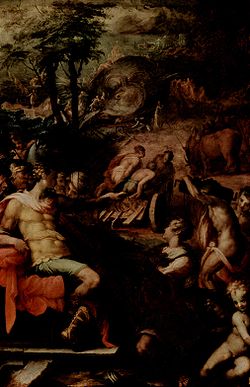
Giovanni Battista Naldini
Encyclopedia

Italy
Italy , officially the Italian Republic languages]] under the European Charter for Regional or Minority Languages. In each of these, Italy's official name is as follows:;;;;;;;;), is a unitary parliamentary republic in South-Central Europe. To the north it borders France, Switzerland, Austria and...
painter
Painting
Painting is the practice of applying paint, pigment, color or other medium to a surface . The application of the medium is commonly applied to the base with a brush but other objects can be used. In art, the term painting describes both the act and the result of the action. However, painting is...
of a late-Mannerism
Mannerism
Mannerism is a period of European art that emerged from the later years of the Italian High Renaissance around 1520. It lasted until about 1580 in Italy, when a more Baroque style began to replace it, but Northern Mannerism continued into the early 17th century throughout much of Europe...
in Florence
Florence
Florence is the capital city of the Italian region of Tuscany and of the province of Florence. It is the most populous city in Tuscany, with approximately 370,000 inhabitants, expanding to over 1.5 million in the metropolitan area....
.
His first apprenticeship (1549–57) was in the studio of Jacopo Pontormo. He went from Rome
Rome
Rome is the capital of Italy and the country's largest and most populated city and comune, with over 2.7 million residents in . The city is located in the central-western portion of the Italian Peninsula, on the Tiber River within the Lazio region of Italy.Rome's history spans two and a half...
for a number of months following 1560, and was recruited to work for Giorgio Vasari
Giorgio Vasari
Giorgio Vasari was an Italian painter, writer, historian, and architect, who is famous today for his biographies of Italian artists, considered the ideological foundation of art-historical writing.-Biography:...
in 1562. He painted two crowded, mannerist canvas for the Studiolo of Francesco I
Studiolo of Francesco I
The Studiolo was a small painting-encrusted barrel-vaulted room in the Palazzo Vecchio, Florence, commissioned by Francesco I de' Medici, Grand Duke of Tuscany. It was completed for the duke from 1570-1572, by teams of artists under the supervision of Giorgio Vasari and the scholars Giovanni...
in the Palazzo Vecchio
Palazzo Vecchio
The Palazzo Vecchio is the town hall of Florence, Italy. This massive, Romanesque, crenellated fortress-palace is among the most impressive town halls of Tuscany...
: the Allegory of Dreams and the Gathering of Ambergris
Ambergris
Ambergris is a solid, waxy, flammable substance of a dull gray or blackish color produced in the digestive system of and regurgitated or secreted by sperm whales....
.
He supplied altarpieces to Santa Maria Novella and Santa Croce
Basilica di Santa Croce di Firenze
The Basilica di Santa Croce is the principal Franciscan church in Florence, Italy, and a minor basilica of the Roman Catholic Church. It is situated on the Piazza di Santa Croce, about 800 metres south east of the Duomo. The site, when first chosen, was in marshland outside the city walls...
. He painted an altarpiece of Calling of Saint Matthew for the Salviati Chapel in San Marco
San Marco, Florence
San Marco is the name of a religious complex in Florence, Italy. It comprises a church and a convent. The convent, which is now a museum, has three claims to fame: during the 15th century it was home to two famous Dominicans, the painter Fra Angelico and the preacher, Girolamo Savonarola...
, where he worked alongside Francesco Morandini
Francesco Morandini
Francesco Morandini was an Italian painter active in Florence, working in a Mannerist style. He was also called il Poppi after his native town...
. Ultimately, he is aptly described by Freedberg as displaying work distantly derivative from the style of Andrea del Sarto
Andrea del Sarto
Andrea del Sarto was an Italian painter from Florence, whose career flourished during the High Renaissance and early Mannerism. Though highly regarded during his lifetime as an artist senza errori , his renown was eclipsed after his death by that of his contemporaries, Leonardo da Vinci,...
, as expressed by Naldini's two mentors and Sarto's two pupils: Pontormo and Vasari. Among his pupils were the Cavalieri Francesco Curradi
Francesco Curradi
Francesco Curradi was an Italian painter of the style described as Contra-Maniera or Counter-Mannerism, born and active in Florence....
.
Naldini painted the cycle of frescoes concerning St. John the Baptist in Rome, in the chapel of St.John the Baptist in Chiesa della Trinità dei Monti
Trinità dei Monti
The church of the Santissima Trinità dei Monti is a late Renaissance titular church in Rome, central Italy. It is best known for its commanding position above the Spanish Steps which lead down to the Piazza di Spagna...
in Rome in 1580. The chapel, which was added to the original church during works for the new facade, was built in 1570 by the architect Giovanni Antonio Dosio
Giovanni Antonio Dosio
Giovanni Antonio Dosio was an Italian architect and sculptor.He was born in San Gimignano. A student of Ammanati, with whom he realized the Villa dell'Ambrogiana, Dosio worked primarily in Rome and Florence , with some commissions that took him to Naples.During his early years in Rome, where he...
. In 1573 the Florentine banker Giovanni Battista Altoviti acquired the patronage and dedicated the chapel to St. John the Baptist, the Patron Saint of his city. In about 1580 Giovanni Battista Naldini created the frescoes that are still well-preserved today.

